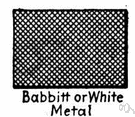Babbitt metal
n.
1. Any of several soft, silvery antifriction alloys composed of tin usually with small amounts of copper and antimony.
2. See white metal.
[After Isaac Babbitt (1799-1862), American inventor who patented such an alloy.]
American Heritage® Dictionary of the English Language, Fifth Edition. Copyright © 2016 by Houghton Mifflin Harcourt Publishing Company. Published by Houghton Mifflin Harcourt Publishing Company. All rights reserved.
Babbitt metal
n
(Metallurgy) any of a number of alloys originally based on tin, antimony, and copper but now often including lead: used esp in bearings. Sometimes shortened to: Babbitt
[C19: named after Isaac Babbitt (1799–1862), American inventor]
Collins English Dictionary – Complete and Unabridged, 12th Edition 2014 © HarperCollins Publishers 1991, 1994, 1998, 2000, 2003, 2006, 2007, 2009, 2011, 2014
Bab′bitt met`al
n.
any of various alloys of tin with smaller amounts of antimony and copper, used as an antifriction lining for bearings.
[1870–75; after Isaac Babbitt (1799–1862), U.S. inventor]
Random House Kernerman Webster's College Dictionary, © 2010 K Dictionaries Ltd. Copyright 2005, 1997, 1991 by Random House, Inc. All rights reserved.
Babbitt
A soft metal used as a bearing lining. It was usually a mixture of tin (fifty parts), antimony (five parts), and copper (one part).
1001 Words and Phrases You Never Knew You Didn’t Know by W.R. Runyan Copyright © 2011 by W.R. Runyan
 Babbitt metal - an alloy of tin with some copper and antimony; a lining for bearings that reduces friction
Babbitt metal - an alloy of tin with some copper and antimony; a lining for bearings that reduces friction